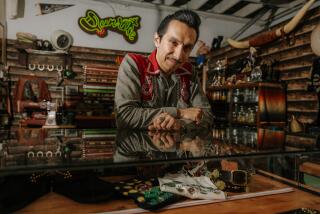Designers tie it together
Silk scarves are a canvas for bright color and artsy design. Today, a new generation of scarf designers is putting its animated stamp on the process, using digital technology and the Internet to bring humor and bold color to the work. Meet three of today’s influential scarf makers.
Anna Coroneo
London and New York City
I worship color. I grew up in Australia and feel that having spent my childhood in the outdoors exploring the native flora and fauna there has had an impact on my life and design aesthetic. Warm weather, sunshine and music always make me happy. I’m also passionate about studying art history, and my collections have hints of inspiration from pop artists, such as Keith Haring and Andy Warhol.
Fashion that sparks conversation and has a humorous fun story or concept behind it can bring a lot of joy to life. Once, my husband and I were in Venice [Italy], and some lovely ladies from the U.S. asked about the scarf I was wearing, my lipstick-kisses scarf. They asked me to go to my room and then bought every single scarf I’d packed. We were brought together by the humor and fun of fashion.
------------
FOR THE RECORD:
Scarf artists: A July 20 article about artists who design scarves gave an incorrect website ( www.annacoreneo.com) for Anna Coroneo’s work. The correct website is www.annacoroneo.com. Also, a photo credit on the section’s cover misspelled scarf label Chrisu as Crisu. —
------------
As all of my designs are created first from my artworks, I like the digital process of printing on fabrics as the prints closely represent my original (pieces). In many of my scarves, you can see my brush strokes; the detail is so precise.
I endeavor to create designs that have an Australian influence, injected also with the vibe of busy cities — the energy of New York and London.
Sold at net-a-porter.com, Neiman Marcus, Harrods, select Bloomingdale’s and www.annacoroneo.com.
Karen Mabon
Edinburgh, Scotland
I started making scarves after I graduated from London’s Royal College. I felt bored by the prints available. I wanted weird, strange, different, but it was all butterflies and swallows. When I decided to start designing my own, I looked at the Hermes archives and discovered that they used to work with artists on their scarves, which I thought fantastic.
I wanted to bring a new dimension to a flat artwork, to allow the viewer to interact with the piece in a completely different way. When you wear something, it’s so intimate; you don’t wrap many things around your neck. You can also get away with something really mad and bright because when it’s all tied up in a ball, you only see a chink of color. I try and think more now about how the scarves look when they’re all wrapped up and try to put something interesting on the corners because they tend to poke out.
The very nature of fashion is that it’s really disposable, and this lack of permanence lends itself well to [humor]. There’s nothing like tying a fun, bright scarf around your neck on a gray day to make you feel good.
I use a combination of digital and hand-printing processes and design everything by hand in my Edinburgh studio. I then send the drawings to a factory in Como [Italy]. I think the silk twill square is such a design classic, and such a traditional format, that I like to contradict this with a design that’s tongue-in-cheek.
Sold at www.karenmabon.com.
Christin Chang
West Haven, Conn.
I decided to start my own scarf line
[Chrisu] when I noticed my own personal collection of scarves untouched in my drawer. The classical silk scarves and their styling felt very limited. I wanted to create a brand that reintroduces silk scarves in a more versatile and wearable way with whimsical prints but still preserves the elegance of hand-painted silk scarves.
All of our scarves are hand-painted by water color and then digitally manipulated to create the layout of pattern. This process usually takes from three to six months. Then they’re sent over to our printers in Korea to be printed. There is a big part of me that wants to preserve the beauty of hand-drawn things through my scarves.
In everything I design, it’s important to have a story. If the story is funny that makes it better. Clothing with narrative has more personality, and it makes it more unique. I love having a humorous design on my scarves because when you wear a scarf, most of the design gets hidden within the fold and all you see is a very small portion of the whole art work, so it’s almost like having a funny secret to yourself.
Sold at www.chrisu.com.






